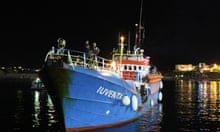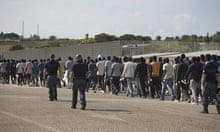The Italian government has hailed a fall of more than 50% in the number of migrants from Libya reaching its coastline in July as a potential turning point made possible by tougher actions against smugglers operating in the Mediterranean.
The number of migrants reaching Italy fell to 11,459 in July from 23,524 in June and 23,522 in July last year. Over the past few years the summer months have been the peak period for traffickers in the Mediterranean.
The fall in numbers making the crossing is likely to be the result of a more aggressive turnaround policy by the Libyan navy and coastguard, backed by improved boats and equipment – funded by the European Union – and Italian-led training. In the past few days, the Libyan coastguard has fired warning shots at one NGO ship seeking to rescue migrants. At a press conference on Thursday the Libyan navy underlined the message by telling foreign ships to stay outside Libya’s search and rescue zone.
Italy, including its coalition government, is deeply divided over its response to the migrant crisis, but ministers are desperate for any sign that it is is managing to bring numbers under control as it faces attack from populist and centrist parties.
Matteo Renzi, who is likely to be the Democratic party leader in elections expected next year, welcomed the July and early August fall as significant.
However, even if the July fall is maintained through August, about 140,000 migrants are projected to reach Italy this year.
The Italian government’s efforts to drive the figures down are under political attack both domestically and in Libya.
At home, the Italian government is pressing NGOs that are operating rescue ships to sign up to a 13-point code of conduct or else finds their ships barred from landing in Italian ports. So far four NGOs have agreed, with four refusing on the grounds it requires them to allow the Italian military to accompany their rescue missions, something they say is in breach of humanitarian principles.
A vociferous political campaign has claimed the NGOs are not humanitarians, but working in tandem with the smugglers to act as a taxi service for African economic migrants that want to start a more prosperous life in Europe. The allegations have not been proven, and each of the NGOs has rescued tens of thousands of migrants from drowning.
The Italian transport minister, Graziano Delrio, who is responsible for the coastguard, has privately sided with some of the NGOs, saying that while he is not opposed to the code, “if there is an NGO vessel close to people who need to be rescued, I can’t exclude it”. He argues that even if an NGO has not signed the code, the coastguard had to cooperate if human lives were at stake, pointing out this is anyway a requirement of international humanitarian law. So far four NGOs have signed code - the Spanish NGO ProActiva, Save the Children, Moas and Sea-Eye. NGOs that have not signed include Sea-Watch, and Medicines Sans Frontiers.
But Loris De Filippi, the president of Médecins Sans Frontières Italy which has not signed the code, claimed the Italian government was seeking to criminalise the NGOs. He said the vast majority of its rescues took place 30 miles or so off the Libyan coast and follow requests from the Italian coastguard.
In Libya, the UN-backed government of Fayez al-Sarraj is under attack for agreeing to allow Italian military ships help the Libyan coastguard combat smugglers inside Libyan coastal waters. The rival Libyan administration based in Tobruk claims the agreement violates Libya’s sovereignty and the Italian flag has been burned in Benghazi in protest. The scale of the protests has forced Rome to reduce the number of ships it sends. As the former colonial power, any perceived Italian interference in Libya is highly sensitive.
The commander of the eastern forces in Libya, Khalifa Haftar, has ordered his air force and naval force troops to bomb any foreign vessels in the Libyan waters but the Libyan navy seems prepared to defy the threats and cooperate with the Italian navy.
Italy’s defence ministry said the plan has UN backing and its ships are merely “providing logistical, technical and operational support for Libyan naval vessels, helping them and supporting them in shared and coordinated actions”.







